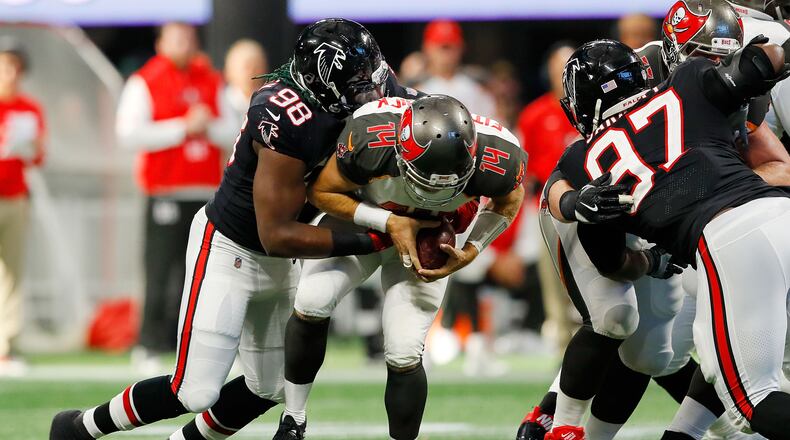He arrived, as first-round picks should, with a reputation. Takk McKinley came as a “sudden” defensive end, a guy with jets who could help the Falcons turbo-charge their pass rush.
Shoot, even though he missed all offseason workouts while finishing classes at UCLA and rehabbing a surgically repaired shoulder, McKinley wasted no time in making impressions after he was cleared to participate in training camp.
On his first full-speed NFL rep, he blasted past left tackle Jake Matthews like he wasn’t there and sacked quarterback Matt Ryan in training camp.
Fellow defensive end Derrick Shelby remembers thinking, “He’s fast. This guy can run. Explosive, too.”
That explosive part may come as a surprise to anyone willing to disassociate the word from speed and consider connecting it to a description of power.
Dude, a word used by defensive line coach Bryant Young, has some muscle.
With sacks in consecutive games, McKinley has surprised some with his strength. Coming off the bench, he doesn’t look anything like, say, Hall of Fame defensive end Reggie White, who was massive.
The Takkster’s hips are no wider than yours (probably). Julio Jones may have shoulders even more broad.
But look closely on those rare occasions when he’s in the locker room long enough and you see this barrel chest. There’s a thickness in his upper arms, too, that doesn’t match a relatively lean skeletal frame.
Apparently, all that works.
He even plays inside at tackle occasionally in nickel situations.
“Actually, I knew he had speed. I knew he was physical, but ... it’s kind of uncanny, when he makes contact he has momentum, he can knock dudes back,” Young reported. “He’s really strong at the point of contact. To me that’s not a surprise, but an absolute bonus.”
The bonus is used at McKinley’s discretion.
Young said there are no defensive play-calls that mandate McKinley coming off his right defensive end spot in relief of Adrian Clayborn to use a speed move or a power move. It’s Takk’s choice.
And he’s still trying to figure all of that out, although one could suggest that he’s ahead of schedule, with four sacks and eight quarterback hits in 11 games.
End/linebacker Vic Beasley, another first-round draft choice who led the NFL in sacks last season – his second as a pro – with 15.5, had four sacks as a rookie.
“It just depends on who we’re facing,” McKinley said of his choices. “If it’s a scrambling quarterback, you don’t really want to get too far upfield because he’s just going to take off a run, so it kind of depends on who we’re facing. You’ve got to be smart.”
Truth be told, some decisions are made earlier in the week before a game.
Offensive tackles are not all alike. Film study matters, and watching the way an opponent goes about his work factors into the decisions that McKinley might make on a play-to-play basis.
“Pass rushing for a young guy can be challenging because each week it’s kind of like a pitcher facing different batters. You’d better have a couple different things,” said coach Dan Quinn, whose background lies along the defensive line.
“This tackle may set up this way, and the next one does it that way, so you kind of have to go through. It takes time for a young guy to learn that. We certainly went through it with Vic.”
Takk’s not necessarily happy with his work so far. His hand play has to improve.
He has forced a fumble and recovered a fumble, defended a pass and obviously has four sacks. Yet he feels like he’s behind the curve.
“I’d say the biggest thing for me is just keep improving on my pass-rush techniques. I need to start use my hands a little bit more,” he said. “Sometimes, I let offensive linemen get inside my pads. I’ve got to learn to shoot my hands better, and be more physical at the line of scrimmage.”
Young agrees.
McKinley’s physical skills are surpassing, yet he may elevate himself to another level by tending to and refining finer points. His hands are often too wide after a snap, and offensive linemen too frequently get a grip and stall him because he doesn’t shed a tackle’s hands and keep the blocker from locking on.
“I think that can be better in terms of being in control and placement, and being exact and consistent in that,” Young said. “As a defensive lineman, no matter what position you play, whether it’s nose tackle, a zero nose, shade, two out ... across the board from zero (over center) all the way out to nine technique, you have to have great hands.”
There’s work ahead for McKinley.
Young said the young player is still learning to play, “six technique,” where he’s head up on a tight end as opposed to lining up outside in a “nine technique.”
McKinley is learning fast, and yet has much to learn. Already, he’s overpowering people frequently while playing roughly 30 percent of the Falcons’ defensive snaps.
The Falcons’ brass believes he can get much better still with brainpower.
“You feel his speed and toughness, for sure. His pass rush from the beginning has been good because of his get-off,” Quinn said. “I think he’s starting to understand the game more clearly now, when to take a shot, when not to, based on situations. He still has a reckless attitude, and the style we like.”
About the Author



